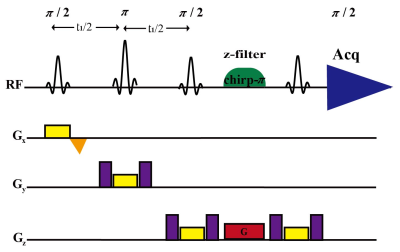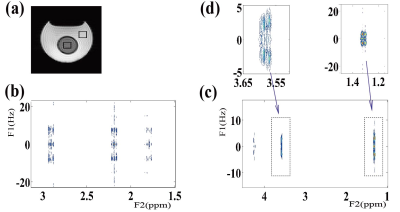1284
High resolution localized 1D homonuclear decoupled in phase MR spectroscopy via z-filtered 2D J-spectroscopyLin Yanqin1, Bo Duan1, Dan Tian1, Qing Zeng1, and Zhong Chen1
1Department of Electronic Science, Xiamen University, Xiamen, China
Synopsis
Proton 1D MR spectroscopy is an important tool in the study of a number of diseases. However, due to multiplet structure and narrow proton chemical shift range, 1D spectra become complicated for direct assignment and quantification. Homonuclear broadband decoupled spectra can be obtained by separating the chemical shift and J coupling information into orthogonal axes in the conventional JPRESS spectra. However, they suffer low resolution because of phase-twisted lineshape. Here, a J-resolved alike experiment with z-filtered module is introduced for the selection of in phase magnetization, and thus high resolution phase sensitive localized 1D spectra can be obtained.
Introduction
Proton 1D MR spectra, such as PRESS and STEAM spectra, have been playing important roles in the study of a number of diseases and disorders. However, due to multiplet structure caused by J coupling and narrow proton chemical shift range, especially under clinical magnetic fields usually no larger than 3T, 1D proton spectra become complicated for direct assignment and quantification. It is known that homonuclear broadband decoupled spectra can be obtained by separating the chemical shift and J coupling information into orthogonal axes in the conventional JPRESS spectra. Conventional 2D J-resolved spectra, however, suffer low resolution because of phase-twisted line shape. Here, a localized 2D J-resolved spectroscopy (JPRESS) 1 alike experiment with z-filtered module is introduced for the selection of in phase magnetization, and thus high resolution phase sensitive localized 1D spectra can be obtained.Methods and Materials
The proposed pulse sequence for high resolution localized 1D homonuclear decoupled in phase MR spectroscopy is shown in Fig. 1. The z-filtered module comprises the last two π/2 pulses sandwiched with a frequency swept adiabatic π pulse along with a simultaneous gradient. Experiments were carried out on a Varian 7.0T/160 mm animal scanner with a 63/95 mm quadrature birdcage coil. The variable power and optimized relaxation delays (VAPOR) module provided by vendor was used to suppress the strong water signal. A phantom built of two concentric glass cylinders was used to demonstrate the feasibility of this new sequence. The inner 12-mm-diameter tube is filled with 1 M threonine solution and the outer 32-mm-diameter tube with 1 M γ-aminobutyric acid (GABA) solution. Two voxels of 5 × 5 × 6 mm3 (see Fig. 2a) were prescribed to cover only inner tube and only outer tube, respectively. The raw data were saved and processed using home-made software.Results
JPRESS alike spectra with the full multiplet are shown in Fig. 2b and c. The full multiplet obtained by the experiment can be reduced by a simple pattern recognition algorithm2, which is based on the identification of the multiplet center and subsequent reduction of the expected peaks. Then 1D homonuclear decoupled in phase spectra can be obtained by projection on the F2 dimension, shown in Fig. 3e and f. PRESS spectra and 1D homonuclear decoupled projection spectra from JPRESS are also present for comparison.Discussion
Comparing Fig. 3e and f with Fig. 3a - d, 1D homonuclear decoupled in phase spectra show similar localization results as JPRESS and PRESS, demonstrating the good localization property. In comparison of Fig. 3c-f with Fig. 3a and b, 1D homonuclear decoupled projection spectra clearly outperform in the direct identification of spectral peak. The phase sensitive spectra have better resolution compared with the conventional homonuclear decoupled spectra obtained by JPRESS, showing the utility of our new method. This will facilitate direct spectral assignment and quantification.Acknowledgements
This work was partially supported by the National Natural Science Foundation of China under Grants U1732158, and Fundamental Research Funds for the Central Universities under Grant 20720170036.References
(1) T.M. Albert, L.N. Ryner, M.P. Mehta, P.A. Turski, J.A. Sorenson. J. Magn. Reson. Imaging 6 (1996) 453-459. (2) S. Simova, H. Sengstschmid, R. Freeman. J. Magn. Reson. 124 (1997) 104-121.Figures

Figure 1. The pulse sequence for
high resolution localized 1D homonuclear decoupled in phase MR spectroscopy.

Figure 2. (a) The axial image
of the phantom with black boxes indicating voxel position, (b, c) JPRESS
spectra of the outer voxel (b) and inner voxel (c) acquired by the sequence
shown in Fig. 1, (d) expansion view of Fig. c.

Figure 3. (a, b) 1D PPESS
spectra, (c, d) 1D projection spectra from conventional JPRESS spectra, (e, f)
projection spectra of Fig. 2b and c after applying multiplet reduction
algorithm. The left panel is from the outer voxel, and right from the inner
voxel.